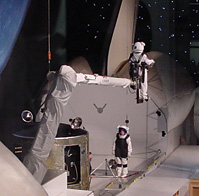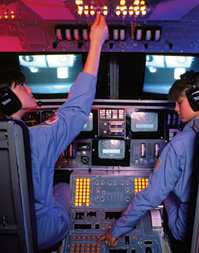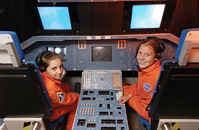DAY 1 | SUNDAY
Today your child arrives at the international airport in Hunstville, Alabama, where an A&K Space representative meets your child at the gate, helps with luggage and escorts him/her to the U.S. Space & Rocket Center®. Your child attends an afternoon orientation, and then enjoys dinner with fellow "young astronauts-in-training," followed by a space-themed movie at the on-site IMAX Theater. Tonight, the children tour the USSRC facilities, located on 400-plus-acres in the heart of the Tennessee Valley, and review the week’s activities, which pair the finest space and aviation programming with custom events.
USSRC D
Note: All overnights are at the U.S. Space & Rocket Center’s accommodations facility; all meals are at the USSRC dining facility, unless otherwise stated.
DAY 2 | MONDAY
After breakfast, your child heads to the Aviation Challenge® hangar. Using state-of-the-art simulators, the kids receive flight-training instruction before taking the controls of a Navy F-18 Super Hornet. After lunch, they tour the museum’s world-class collections of rockets and space memorabilia. Later, the spinning
Multi-Axis Trainer (see
Astronaut Training Simulator Guide, below), which helped prepare NASA’s Mercury team, simulates a re-entry from Space. Today’s other simulator experiences: an accelerator that literally raises kids off their seats, and
Space Shot, a 140-foot vertical launch with several seconds of weightlessness. The day winds-down with an IMAX show and hot popcorn.
USSRC B L D
DAY 3 | TUESDAY
NASA’s Mars explorations are the morning’s focus. Then, it’s a comprehensive, simulator-based mission with the kids working in teams to successfully Launch the Shuttle. This afternoon includes a seat in the
5 Degrees of Freedom Chair, a simulator used by the Gemini and Apollo astronauts to practice moving in five directions: forward and backward, side-to-side, roll, pitch, and yaw. Later, a briefing on “survival tactics” might come in handy as tonight’s outdoor barbecue in the campus woods is followed by an intriguing game of Escape and Evasion.
USSRC B L D
DAY 4 | WEDNESDAY
After breakfast, your child and his/her fellow astronauts-in-training design a commemorative team patch and build a one-stage model rocket to launch at week’s end. This afternoon, he/she engages in simulated “dog fighting,” testing reflexes, teamwork and strategy, followed by seasonal water activities at the campus lake, weather permitting. After dinner activities include the Mars climbing wall, “strange science” with wacky space-related experiments and an IMAX special feature.
USSRC B L D
DAY 5 | THURSDAY
Does your child dream of walking on the Moon? Today, a
1/6th Gravity Simulator makes your child feel just a fraction of his/her Earth weight, a perfect tool for lunar exploration. Later, each team launches its model rocket, measuring distance and flight profiles. This afternoon, your child and his/her group members embark on a special field trip. They travel by coach to the Von Braun Astronomical Society Planetarium at nearby pristine Monte Sano State Park, where they have dinner at a rustic mountain lodge with a special host — a real NASA Astronaut! When night falls, the children observe the stars, Moon and planets by telescope, taking in the celestial sky with a new understanding, before returning to the USSRC for their last overnight.
USSRC B L D
DAY 6 | FRIDAY
After breakfast, your child and the other young astronauts-in-training attend their graduation ceremony and say good-bye to friends and counselors. In late morning, your child is transferred to the airport, escorted to his/her gates and supervised by camp staff until it’s time to depart for home.
USSRC B
Note: The sequence of daily activities may vary. Staff will disseminate itinerary changes if/as they occur.
ASTRONAUT TRAINING SIMULATOR GUIDE
1/6TH GRAVITY SIMULATOR
Restrictions
Height: No restriction
Weight: 260 lbs. maximum
Designed to give trainees an idea of what it is like to walk on the Moon, this simulator is patterned after the one Apollo astronauts used for moonwalk training. The chair is called the 1/6th Gravity Chair because it simulates the Moon's gravitational pull, which is 1/6th that of the Earth's. For example, a person who weighs 120 lbs. on Earth would weigh 20 lbs. on the moon.
MULTI-AXIS TRAINER
Restrictions
Height: Head, hands and feet must reach restraints. Straps must fit tightly.
Weight: 260 lbs. maximum
The Multi-Axis Trainer simulates the disorientation one would feel in a tumble spin during reentry into the Earth's atmosphere. The MAT is patterned after the MASTIF (Multi-Axis Spin Test Inertial Facility), a series of cages within cages, used for astronaut training during NASA’s Mercury program. Astronauts used the MASTIF to condition themselves for disorientation that might occur in emergency conditions during flight.
Because the trainee's stomach stays centered, nausea shouldn't occur. Also, the MAT shouldn't spin more than twice in a row in the same direction. This prevents inner-ear fluid shifts and the dizziness that results.
5 DEGREES OF FREEDOM (5DF) SIMULATOR
Restrictions
Height: 4 ft. (48 in.) minimum
Weight: 260 lbs. maximum
Gemini and Apollo astronauts used the 5 Degrees of Freedom Simulator to practice moving in a microgravity environment. The trainer allowed the astronauts to move in five different directions: Forward and backward, side-to-side, roll, pitch, and yaw. The sixth degree of freedom, up and down, cannot be simulated in this chair.
The 5DF runs on air bearings to simulate the frictionless environment of Space and demonstrates Newton's Third Law of Motion: For every action, there is an equal and opposite reaction.
MANNED MANEUVERING UNIT (MMU) 1-G TRAINER
Restrictions
Height: 4 ft. (48 in.) minimum
Weight: 260 lbs. maximum
The MMU 1-G Trainer simulates the MMU's controlled maneuverability in Earth orbit. In an MMU, the astronauts on a shuttle mission can travel untethered for short distances to perform satellite retrieval and repair, inspections of the orbiter surfaces, and other activities.
The MMU allows for the experience of working in Space unattached to the spacecraft, which gives astronauts more freedom and mobility to perform activities in space. The MMU uses five degrees of freedom: forward and backward, side-to-side, roll, pitch, and yaw. The trainee can control these movements with joysticks.
to top



